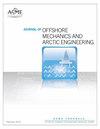嘉宾评论:海洋工程的数据驱动力学和数字孪生
IF 1.3
4区 工程技术
Q3 ENGINEERING, MECHANICAL
Journal of Offshore Mechanics and Arctic Engineering-Transactions of the Asme
Pub Date : 2022-10-18
DOI:10.1115/1.4056012
引用次数: 0
摘要
本期特刊的主题是海洋工程的数据驱动力学和数字孪生。本期包括两类论文;它们涉及:(i)降阶建模和数据分析;二数据驱动的计算和数字孪生。在第一类中,Yin等人提出了使用动态模态分解(DMD)对流激振动中的水动力进行模态分析。利用流场快照,分析了尾流模式的时空演化特征。识别出具有相应频率的主要DMD模式,并将其用于重建流场。在这一类别的另一篇论文中,Janocha等人通过适当的正交分解(POD)分析,对柔性安装圆柱体周围的流动进行了三维大涡模拟和数据驱动分析。对尾流中的切片进行基于POD的模态提取,以识别流中的相干结构。通过对三维尾流结构的研究,对旋涡脱落模式进行了分析和分类。这样的工作对于构建可用于多查询分析、设计优化和反馈控制的降阶(代理)模型是有用的。然而,这些POD/DMD研究仅限于线性物理学以及理想化的正则几何。需要进一步扩展到大型海洋和海上结构(例如,海上风力涡轮机、海上立管和管道)。此外,对于高度非线性的湍流,基于投影的POD/DMD技术通常面临缩放的困难。非线性模型约简和深度神经网络(例如,卷积自动编码器)是探索高级降阶建模的可能替代方案。本文章由计算机程序翻译,如有差异,请以英文原文为准。
Guest Editorial: Data-Driven Mechanics and Digital Twins for Ocean Engineering
This special issue focuses on the topic of Data-Driven Mechanics and Digital Twins for Ocean Engineering. Two categories of papers are included in this issue; they deal with: (i) reduced-order modeling and data analytics; and (ii) data-driven computing and digital twins. In the first category, Yin et al. present the modal analysis of hydrodynamic forces in flow-induced vibrations using dynamic mode decomposition (DMD). Using snapshots of the flow field, spatio-temporal evolution characteristics of the wake patterns are analyzed. The dominant DMD modes with their corresponding frequencies are identified and used to reconstruct the flow fields. In another paper in this category, Janocha et al. presented a 3D large-eddy simulation and data-driven analysis of the flow around a flexibly mounted cylinder via proper orthogonal decomposition (POD) analysis. The POD-based modal extractions are performed on slices in the wake to identify the coherent structure in the flow. Vortex shedding modes are analyzed and classified by examining three-dimensional wake flow structures. Such a body of work is useful for building reduced-order (surrogate) models that can be considered for multi-query analysis, design optimization, and feedback control. However, these POD/DMD studies are restricted to linear physics as well as to idealized canonical geometries. There is a need for further extension to large-scale marine and offshore structures (e.g., offshore wind turbines, marine risers and pipelines). Moreover, projection-based POD/DMD techniques generally face difficulties to scale for highly nonlinear turbulent flow. Nonlinear model reduction and deep neural networks (e.g., convolutional autoencoders) are possible alternatives to be explored for advanced reduced-order modeling.
求助全文
通过发布文献求助,成功后即可免费获取论文全文。
去求助
来源期刊
CiteScore
4.20
自引率
6.20%
发文量
63
审稿时长
6-12 weeks
期刊介绍:
The Journal of Offshore Mechanics and Arctic Engineering is an international resource for original peer-reviewed research that advances the state of knowledge on all aspects of analysis, design, and technology development in ocean, offshore, arctic, and related fields. Its main goals are to provide a forum for timely and in-depth exchanges of scientific and technical information among researchers and engineers. It emphasizes fundamental research and development studies as well as review articles that offer either retrospective perspectives on well-established topics or exposures to innovative or novel developments. Case histories are not encouraged. The journal also documents significant developments in related fields and major accomplishments of renowned scientists by programming themed issues to record such events.
Scope: Offshore Mechanics, Drilling Technology, Fixed and Floating Production Systems; Ocean Engineering, Hydrodynamics, and Ship Motions; Ocean Climate Statistics, Storms, Extremes, and Hurricanes; Structural Mechanics; Safety, Reliability, Risk Assessment, and Uncertainty Quantification; Riser Mechanics, Cable and Mooring Dynamics, Pipeline and Subsea Technology; Materials Engineering, Fatigue, Fracture, Welding Technology, Non-destructive Testing, Inspection Technologies, Corrosion Protection and Control; Fluid-structure Interaction, Computational Fluid Dynamics, Flow and Vortex-Induced Vibrations; Marine and Offshore Geotechnics, Soil Mechanics, Soil-pipeline Interaction; Ocean Renewable Energy; Ocean Space Utilization and Aquaculture Engineering; Petroleum Technology; Polar and Arctic Science and Technology, Ice Mechanics, Arctic Drilling and Exploration, Arctic Structures, Ice-structure and Ship Interaction, Permafrost Engineering, Arctic and Thermal Design.

 求助内容:
求助内容: 应助结果提醒方式:
应助结果提醒方式:


